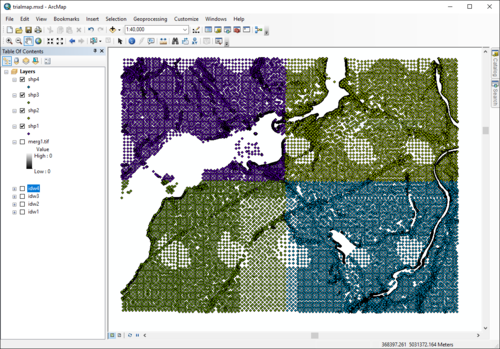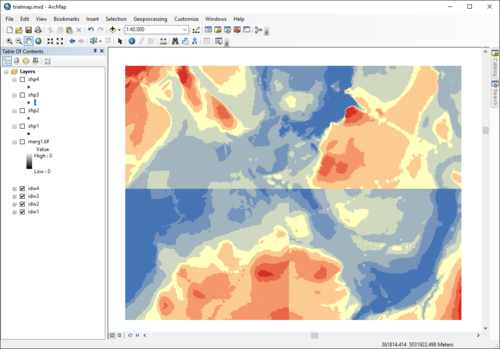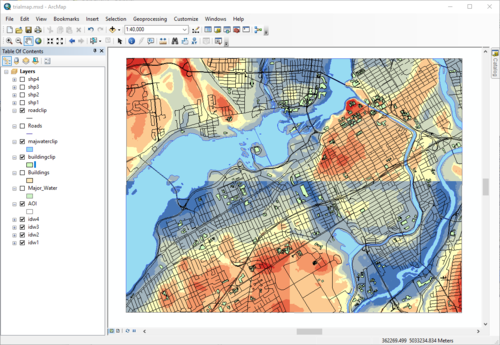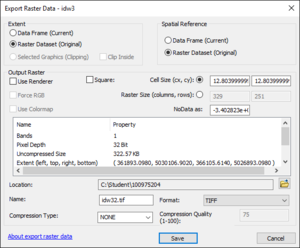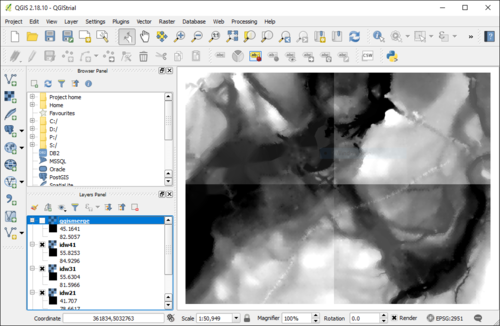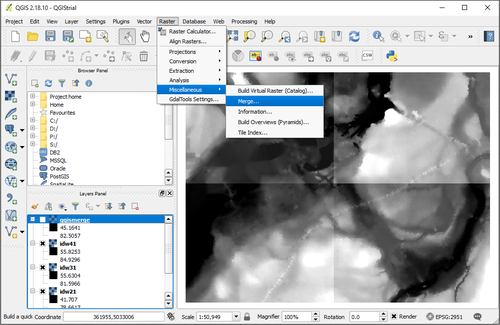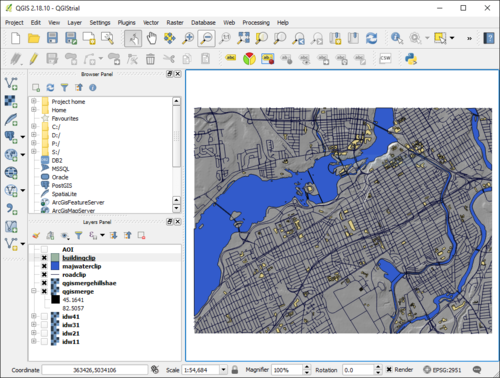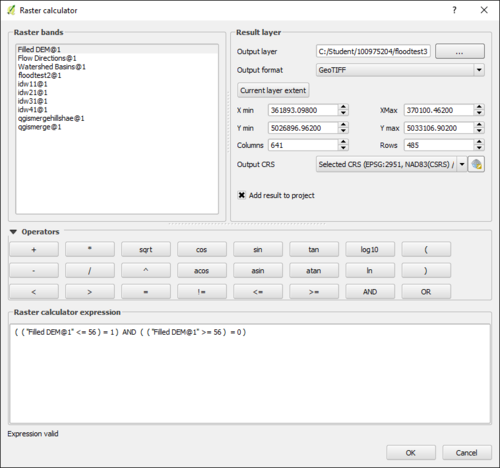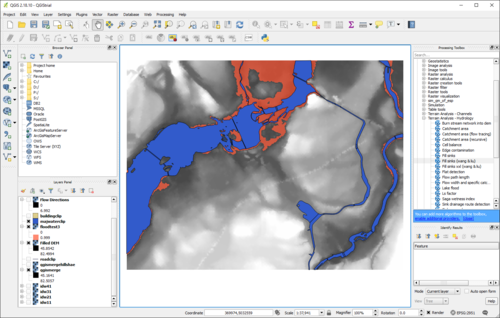Flood Risk Assessment in QGIS
Contents
Introduction
Flood assessment is one of many important purposes for which GIS capabilities can be applied in a practical manner. The scope of the analysis in the tutorial includes a portion of the downtown core of Ottawa, ON. This analysis is particularly relevant due to the high number of flooding events and high-rainfall in Ottawa, especially in 2017. By completing flood risk assessments the city can identify at-risk buildings/populations, as well as develop stronger preparedness measures for when a flood does occur.
The purpose of this tutorial is to provide users with an introduction/guidance in completing a flood risk assessment. The software that will be used is QGIS (ver. 2.18.10) as well as ArcMap (ver. 10.5.1) solely for preliminary data processing.
Data and Software Requirements
In order to begin this tutorial a download of the QGIS software is needed. The current version is QGIS 2.18.15 'Las Palmas' and was released on 08.12.2017. QGIS is available on Windows, MacOS X, Linux as well as Android. This can be found at QGIS Download
Moving forward, the elevation data that will be used for this tutorial can be found from this link. For the purpose of this analysis, 4 adjacent elevation tiles of the city of Ottawa were downloaded, which make a 4-tiled square. Be sure to download the files as shapefiles, not DEMs.
You may use whatever additional base layers you might like to add to this tutorial, but for this purpose, only roads, buildings, and water body data is used which can be found here In addition to the major waterways, roads and building data, this dataset also provides contours, airports, railroads, etc.; but for the purpose of this tutorial, please use ‘Major_Water.shp’; ‘Roads.shp’; and ‘Buildings.shp’.
After all the data is downloaded, you may proceed to process the files in ArcMap.
ArcMap Processing
In order to create the proper DEM file needed to process the desired outcome of this tutorial, the four grid files previously mentioned must be loaded into ArcMap and then processed into DEMs using the Spatial Analyst tool: Inverse Distance Weighted (or IDW for short).
We used ArcMap as a tool to process the data into a file type that QGIS would recognize and be used for the computation/analysis processes.
Step 1. Import the four shapefiles that were downloaded through the Carleton Library. Your screen should look something similar to this image
Step 2. Convert the shapefiles to raster using the IDW tool. The result should look very similar to this image
Step 3. Clipping, Major Water, Roads, Buildings Used an AOI polygon feature, that was set to the same extent as the IDW tiles, to clip features. → you can also clip the data in QGIS, but to streamline the process in QGIS, we clipped the data in ArcMap. The result should look similar to this image
Step 4. Export the IDW raster files into a .tif This should be the window that appears after selecting the export data option from right-clicking on the layer file.
QGIS Methods and Instructions
Importing and Merging
Step 1.
- Upload the .tif files into QGIS by navigating through the Browser window.
- Select the folder where your files are saved, (can be added to favourites by right clicking the folder) and drag in all four .tif files to the main window.
- The result should be the four raster images together in a square, as pictured below:
Step 2.
- Use the merge tool (Raster -> Miscellaneous -> Merge) to combine the .tif files into one working layer feature.
- In the merge tool, select the four .tif files through the Input Layers selection, directly under the Parameters tab.
- Once the layers have been selected, click Run in Background in order to merge the files.
- The resulting merged file should look similar to the image below:
Creating an AOI
Step 3.
- At this stage an Area of Interest will be created, so we can clip our Ottawa layers in the next step.
- Navigate to Layers -> Create Layer -> New Shapefile Layer
- At the top of the window, give a name to your new file (AOI is suitable), and select Polygon as the Geometry Type -> At this point a new layer named AOI will be created.
- Right click on the newly created AOI layer, and select Toggle Editing. Once this is selected, navigate to the top panel and find the Add Polygon Feature icon (it looks like the green of a golf course).
- Do your best to draw a border around the Merged layer (hint: use your numpad to move your screen when zoomed in), when complete, right click on the screen and when prompted to save changes to the layer, select Yes.
- The final step of creating an AOI is to right click on the icon/symbology for the layer, and select border. The final AOI and Merged layer should look similar to what is shown below:
Step 4.
- Once the four raster images have merged, and the AOI has been created around it, the City of Ottawa files that were downloaded earlier can be added into QGIS.
- Navigate to the folder they were saved in (same process as importing the .tif files) and drag in the features (vector data) that you want displayed.
- For the purposes of the tutorial, the polygons used were: Major Water, Buildings, Roads, Major Roads, Railroads, and finally Bridges.
- Ensure the polygons are overlaying the merged raster layer, and edit the appearance of each feature as you want (double click on the icon to the left of each layer name).
- The resulting file should appear similar to the image presented below:
Step 5.
- Now that everything we want is added, the vector layers can be clipped to match the extent of the merged raster layer.
- Navigate to Vector -> Geoprocessing Tools -> Clip
- Select the layer you want to be clipped as the Input Layer, and the AOI as the Clip Layer. This clips all parts of the vector layer that is outside the area of the clip layer (the AOI).
- Repeat this process until all the City of Ottawa vector layers have been clipped, renaming each newly created layer as "name" clip, or by removing the original layer and reassigning the name to the clipped layer.
- When all the vector layers have been clipped, the result should look similar to this (remember to symbolize everything that has been clipped):
Sink Fill
Step 6.
- In this step, the Sink Fill (Wang & Liu) was used from the QGIS toolbox. This was used in order to fill any spatial outliers that may have an effect on the overall result of the flood risk assessment.
- Navigate to Processing at the top of the program, and from there select Toolbox, in order to open the list of available tools.
- At the bottom of the list of tools is SAGA, select this and continue down until you reach Terrain Analysis - Hydrology -> Fill Sinks (Wang & Liu)
- Under the dropdown list for DEM select the layer Merged, and select Run (it's also a good idea to save Filled DEM to an Output folder in your primary directory).
- Upon completion, move your move to the layers area, and move the three new layers (Filled DEM, Flow Directions and Watershed underneath the vector layers.
- The final output will look the same as the image in Step 5, if everything has gone correctly.
Raster Calculator
Step 5.
- Raster Calculator is used in this step to establish what areas will be flooded given an increase in water level of 1 meter -- visualized in the example is an increased water level of 1m.
- Navigate to: Raster - Raster Calculator.
- Use the Raster Bands and Operators to recreate the following expression: ( ( "Filled DEM@1" <= 56 ) = 1 ) AND ( ( "Filled DEM@!" >= 56 ) = 0 )
- If entered correctly, Expression Valid will appear under the expression window, and a new new layer will be created.
Result
Step 6.
- Upon completion of the raster calculator, an output of the Ottawa-Gatineau downtown area will be given (same extent we have been working with the entire time).
- The areas that will be flooded given a rise in water levels of ~ 1 meter are in white (1), while the areas that are untouched remain black (0).
- Note: The image below has all other layers hidden in order to see the specific area that will be flooded. In order to determine what infrastructure will be affected (and make use of the previous steps), it is important to add all layers back, as seen in the next step.
Step 7
- At this stage the flood analysis is almost complete, but we want to visualize and demonstrate what has been affected by the rising water levels. Simply turn all infrastructure layers back on (i.e. Buildings, Roads).
- If not visible, move the layers to the top of the Layers tab/window by dragging them above the layer RasterCalcFilled (if not renamed).
- Finally, make adjustments to the symbology (right-click the layer name, Properties, Symbology) and use something that demonstrates if the infrastructure is flooded or not, such as an outline.
- The final output should look similar to the image below:
